Prehistory:
Hominid activity dates back 4 to 5 million years in China, and evidence has been found of early paleolithic hominids living some 1 million years ago. The remains of Homo erectus (Peking Man or Sinanthropus pekinensis), found southwest of Beijing in 1927, date from around 400,000 years ago. Some 7,000 neolithic sites (some as old as ca. 9000 B.C.) have been found in North China, the Yangzi (Changjiang or Yangtze) River Valley, and southeast coastal areas. These sites include a neolithic agricultural village in Shaanxi Province dating from around 4500 B.C. to 3750 B.C., which had a moat for security and evidence of wood-framed, mud and straw houses, colored pottery, slash-and burn farming, and burial sites in nearby cemeteries. The oldest neolithic city found in China was uncovered by archaeologists in Henan Province and dates back to between 4,800 and 5,300 years ago.
Early History:
The first recognized dynasty—the Xia—lasted from about 2200 to 1750 B.C. and marked the transition from the late neolithic age to the Bronze Age. The Xia was the beginning of a long period of cultural development and dynastic succession that led the way to the more urbanized civilization of the Shang Dynasty (1750–1040 B.C.). Hereditary Shang kings ruled over much of North China, and Shang armies fought frequent wars against neighboring settlements and nomadic herders from the north. The Shang capitals were centers of sophisticated court life for the king, who was the shamanistic head of the ancestor- and spirit-worship cult. Intellectual life developed in significant ways during the Shang period and flourished in the next dynasty—the Zhou (1040–256 B.C.).
China’s great schools of intellectual thought—Confucianism, Legalism, Daoism, Mohism, and others—all developed during the Zhou Dynasty.
The intersection of migration, amalgamation, and development has characterized China’s history from its earliest origins and resulted in a distinctive system of writing, philosophy, art, and social and political organization and civilization that was continuous over the past 4,000 years. Since the beginning of recorded history (at least since the Shang Dynasty), the people of China have developed a strong sense of their origins, both mythological and real, and kept voluminous records concerning both. As a result of these records, augmented by numerous archaeological discoveries in the second half of the twentieth century, information concerning the ancient past, not only of China but also of much of East, Central, and Inner Asia, has survived. [see also: Five Emperors]
The Imperial Period:
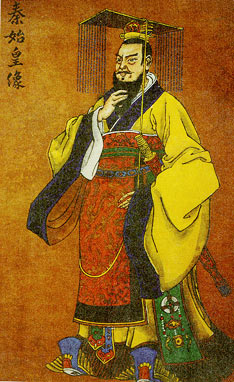 |
Qin Shi Huangdi (秦始皇; Qín Shǐhuáng - 259 BC – 210 BC) King of the Qin state. He became the first emperor of a unified China in 221 BC.
|
Over several millennia, China absorbed the people of surrounding areas into its own civilization while adopting the more useful institutions and innovations of the conquered people. Peoples on China’s peripheries were attracted by such achievements as its early and well-developed ideographic written language, technological developments, and social and political institutions. The refinement of the Chinese people’s artistic talent and their intellectual creativity, plus the sheer weight of their numbers, has long made China’s civilization predominant in East Asia. The process of assimilation continued over the centuries through conquest and colonization until the core territory of China was brought under unified rule. The Chinese polity was first consolidated and proclaimed an empire during the Qin Dynasty (221–206 B.C.). Although short-lived, the Qin Dynasty set in place lasting unifying structures, such as standardized legal codes, bureaucratic procedures, forms of writing, coinage, and a pattern of thought and scholarship. These were modified and improved upon by the successor Han Dynasty (206 B.C.–A.D. 220). Under the Han, a combination of the stricter Legalism and the more benevolent, human-centered Confucianism—known as Han Confucianism or State Confucianism—became the ruling norm in Chinese culture for the next 2,000 years. Thus, the Chinese marked the cultures of people beyond their borders, especially those of Korea, Japan, and Vietnam.
Another recurrent historical theme has been the unceasing struggle of the largely agrarian Chinese against the threat posed to their safety and way of life by non-Chinese peoples on the margins of their territory. For centuries, most of the foreigners that China’s officials saw came from or through the Central and Inner Asian societies to the north and west. This circumstance conditioned the Chinese view of the outside world. The Chinese saw their domain as the self-sufficient center of the universe, and from this image they derived the traditional (and still used) Chinese name for their country—Zhongguo, literally Middle Kingdom or Central Nation. Those at the center (zhong) of civilization (as they knew it) distinguished themselves from the “barbarian” peoples on the outside (wai), whose cultures were presumed to be inferior by Chinese standards. For centuries, China faced periodic invasions from Central and Inner Asia—including major incursions in the twelfth century by the Khitan and the Jurchen, in the thirteenth century by the Mongols, and in the seventeenth century by the Manchu, all of whom left an imprint on Chinese civilization while heightening Chinese perceptions of threat from the north.
Starting in the pre-Qin period, Chinese states built large defensive walls that, in time, composed a “Great Wall.” The Great Wall is actually a series of noncontiguous walls, forts, and other defensive structures built or rebuilt during the Qin, Han, Sui (A.D. 589–618), Jin (1115–1234), and Ming (1368–1643) periods, rather than a single, continuous wall. The Great Wall reaches from the coast of Hebei Province to northwestern Gansu, officially 6,000 kilometers in length, although unofficial estimates range from 2,700 kilometers to as many as 50,000 kilometers, depending on which structures are included in the measurement.
The Tang (618–907) and Song (960–1279) dynasties represented high points of Chinese cultural development and interaction with distant foreign lands. The Yuan, or Mongol, Dynasty (1279–1368) was a period of foreign occupation but of even greater interaction with other cultures. Despite these periods of openness, which brought occasional Middle Eastern and European envoys and missionaries, the China-centered (“sinocentric”) view of the world remained largely undisturbed until the nineteenth century when China first clashed with the European nations.
 |
Puyi (溥仪; 溥儀; Pǔyí - 7 February 1906 – 17 October 1967) the Xuantong Emperor of the Qing Dynasty wearing the imperial Dragon Robe. He was the last Emperor of China.
|
The Manchu had conquered China and established the Qing Dynasty (1644–1911), ushering in a period of great conquest and a long period of relative peace. When Europeans began arriving in increasing numbers, Chinese courtiers expected them to conduct themselves according to traditional tributary relations that had evolved over the centuries between their emperor and representatives of Central Asian states who came via the Silk Road and others who came from Southeast Asia and the Middle East via the sea trade. The Western powers arrived in China in full force at a time of tremendous internal rebellion and rapid economic and social change. By the mid-nineteenth century, China had been defeated militarily by superior Western technology and weaponry, and the government was plagued with ever mounting rebellions. As it faced dynastic breakdown and imminent territorial dismemberment, China began to reassess its position with respect to its own internal development and the Western incursions. By 1911 the millennia-old dynastic system of imperial government was hastily toppled as a result of the efforts of a half century of reform, modernization, and, ultimately, revolution.
 Timeline of Chinese Dynasties Timeline of Chinese Dynasties
Republican China:
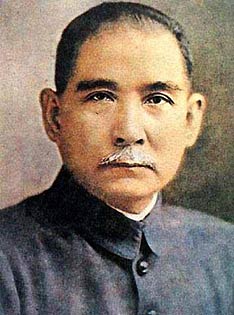 |
Sun Yat-sen (孫中山; 孫逸仙; Sūn Yìxiān - 1866–1925)
Sun Yat-sen (whereas 'Sun' is the family name) was a Chinese statesman; provisional president of the Republic of China 1911–12 and president of the Southern Chinese Republic 1923–25. He organized the Kuomintang force and established a secessionist government at Guangzhou. |
The end of imperial rule was followed by nearly four decades of major socioeconomic development and sociopolitical discord. The initial establishment of a Western-style government—the Republic of China—was followed by several efforts to restore the throne. Lack of a strong central authority led to regional fragmentation, warlordism, and civil war. The main figure in the revolutionary movement that overthrew imperial rule was Sun Yatsen (1866–1925), who, along with other republican political leaders, endeavored to establish a parliamentary democracy. They were thwarted by warlords with imperial and quasi-democratic pretensions who resorted to assassination, rebellion, civil war, and collusion with foreign powers (especially Japan) in their efforts to gain control. A major political and social movement during this time was the May Fourth Movement (1919), in which calls for the study of “science” and “democracy” were combined with a new patriotism that became the focus of an anti-Japanese and antigovernment movement. Ignored by the Western powers and in charge of a southern military government with its capital in Guangzhou, Sun Yatsen eventually turned to the new Soviet Union [today Russian Federation] for inspiration and assistance. The Soviets obliged Sun and his Guomindang (Nationalist Party). Soviet advisers helped the Guomindang establish political and military training activities. A key individual in these developments was Jiang Jieshi (1888–1975; Chiang Kai-shek in Yue dialect), one of Sun’s lieutenants from the early revolution days. But Moscow also supported the new Chinese Communist Party (CCP), which was founded by Mao Zedong (1893–1976) and others in Shanghai in 1921. The Soviets hoped for consolidation of the Guomindang and the CCP but were prepared for either side to emerge victorious. The struggle for power in China began between the Guomindang and the CCP as both parties also sought the unification of China.
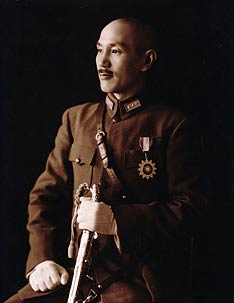 |
Jiang Jieshi known to the west as Chiang Kai-shek - The Generalissimo (蔣中正, 蔣介石; Jiǎng Jièshí - 31 October 1887 – 5 April 1975)
Chinese statesman and general; president of China 1928–31 and 1943–49 and of Taiwan 1950–75. He tried to unite China by military means in the 1930s but was defeated by the Communists. Forced to abandon mainland China in 1949, he set up a separate Nationalist Chinese State in Taiwan. |
Sun’s untimely death from illness in 1925 brought a split in the Guomindang and eventually an uneasy united front between the Guomindang and the CCP. Jiang Jieshi’s military academy trained a new generation of officers who would soon embark on the Northern Expedition. Zhou Enlai (1898–1976), who later become premier of China under the communists, was a political commissar at this academy. Jiang, who succeeded Sun Yatsen, broke with his Soviet advisers and with the communists but by 1927 was successful in defeating the northern warlords and unifying China. The years 1928 to 1937 are often referred to as the Nanjing Decade because of the national development that took place under Jiang’s presidency before World War II when China’s capital was in Nanjing (Southern Capital). The Northern Expedition had culminated in the capture of Beijing, which was renamed Beiping (Northern Peace). Thereafter, the Nanjing government received international recognition as the sole legitimate government of China.
With the 1927 split between the Guomindang and the CCP, the CCP began to engage in armed struggle against the Jiang regime. The Red Army was established in 1927, and after a series of uprisings and internal political struggles, the CCP announced the establishment in 1931 of the Chinese Soviet Republic under the chairmanship of Mao in Jiangxi Province in south-central China. After a series of deadly annihilation campaigns by Jiang’s armies, the Red Army and the CCP apparatus broke out of Jiangxi and embarked on their epic 12,500-kilometer Long March of 1934–35 to a new stronghold in Shaanxi Province in the north. During the march, Mao consolidated his hold over the CCP when in 1935 he became chairman, a position he held until his death in 1976.
“A revolution is not a dinner party, or writing an essay,
or painting a picture, or doing embroidery; it cannot be
so refined, so leisurely and gently, so temperate, kind,
courteous, restrained, and magnanimous.
A revolution is an insurrection, an act of violence by which one class overthrows another.”
Mao Zedong |
Japan invaded Manchuria in 1931, established the puppet government of Manchukuo in 1932, and soon pushed south into North China. The 1936 Xi’an Incident—in which Jiang Jieshi was held captive by local military forces until he agreed to a second front with the CCP—brought new impetus to China’s resistance to Japan. However, a clash between Chinese and Japanese troops outside Beiping on July 7, 1937, marked the beginning of full-scale warfare. Shanghai was attacked and quickly fell. An indication of the ferocity of Tokyo’s determination to annihilate the Guomindang government is reflected in the major atrocity committed by the Japanese army in and around Nanjing during a six-week period in December 1937 and January 1938. Known in history as the Nanjing Massacre, wanton rape, looting, arson, and mass executions took place, so that in one horrific day, some 57,418 Chinese prisoners of war and civilians reportedly were killed.
Japanese sources admit to a total of 142,000 deaths during the Nanjing Massacre, but Chinese sources report upward of 340,000 deaths and 20,000 women raped. Japan expanded its war effort in the Pacific, Southeast, and South Asia, and by 1941 the United States had entered the war. With Allied assistance, Chinese military forces—both Guomindang and CCP—defeated Japan. Civil war between the Guomindang and the CCP broke out in 1946, and the Guomindang forces were defeated and had retreated to a few offshore islands and Taiwan by 1949. Mao and the other CCP leaders reestablished the capital in Beiping, which they renamed Beijing.
People’s Republic of China:
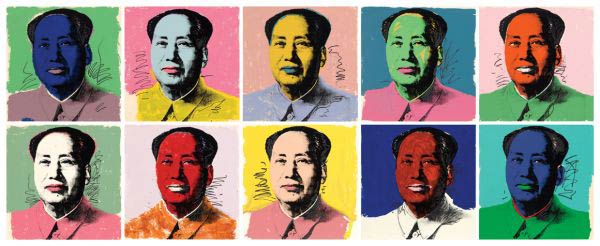 |
Mao Zedong ( 毛泽东; 毛澤東; Máo Zédōng - 26 December 1893 – 9 September 1976)
Chinese statesman; chairman of the Communist Party of the Chinese People's Republic 1949–76; head of state 1949–59. A cofounder of the Chinese Communist Party in 1921 and its effective leader from the time of the Long March (1934–35), he eventually defeated both the occupying Japanese and rival Kuomintang nationalist forces to create the People's Republic of China in 1949.
Popstar Mao - Andy Warhol's iconic image of Mao Zedong was created in the early 1970s, in the time when U.S. President Richard Nixon had the attention of the world (media) with his unexpected visit to China, meeting the 1st Chairman.
|
The communist takeover of the mainland in 1949 set the scene for building a new society built on a Marxist-Leninist model replete with class struggle and proletarian politics fashioned and directed by the CCP. The People’s Republic of China was barely established (October 1, 1949) when it perceived a threat from the United States, which was at war in North Korea, and elected to support its neighbor, the new communist state, the Democratic People’s Republic of Korea. The Chinese People’s Volunteer Army invaded the Korean Peninsula in October 1950 and, along with its North Korean ally, enjoyed initial military success and then a two-year stalemate, which culminated in an armistice signed on July 27, 1953. Meanwhile, China seized control of Tibet. It also had embarked on a political rectification movement against “enemies of the state” and promoting “class struggle” under the aegis of agrarian reform as part of the “transition to socialism.”
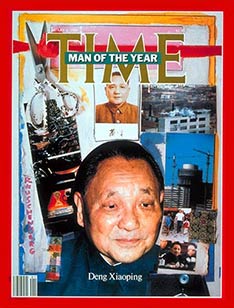 |
Deng Xiaoping (邓小平; 鄧小平; Dèng Xiǎopíng - 22 August 1904 – 19 February 1997)
was a Chinese politician, statesman, theorist, and diplomat and the leader of the Communist Party of China. Discredited during the Cultural Revolution, he was reinstated in 1977 and became the leader of China. In 1989, his orders led to the massacre of some 2,000 pro-democracy demonstrators in Beijing's Tiananmen Square.
TIME Magazine Title US edition, Jan. 6, 1986.
Deng Xiaoping, Man of the Year - Collage by Robert Rauschenberg.
|
Periods of consolidation and economic development facilitated by President Liu Shaoqi (1898–1969) and Premier Zhou were severely altered by disastrous anti-intellectual (such as the Hundred Flowers Campaign, 1957), economic (the Great Leap Forward, 1958–59), and political (the Great Proletarian Cultural Revolution, 1966–76) experiments directed by Mao and his supporters. During this time, China had broken with the Soviet Union by 1959, fought a border war with India in 1962, and skirmished with Soviet troops in 1969. In 1969 Mao anointed Lin Biao (1908–71), a radical People’s Liberation Army marshal, as his heir apparent, but by 1971 Lin was dead, the result of an airplane crash in Mongolia following an alleged coup attempt against his mentor. Less radical leaders such as Zhou and Vice Premier Deng Xiaoping (1904–97), who had been politically rehabilitated after his disgrace early in the Cultural Revolution, asserted some control, and negotiations were initiated with the United States, ending a generation of extreme animosity toward Washington. The 1976 death of Mao ended the extremist influence in the party, and, under the leadership of Deng Xiaoping and his supporters, China began a period of pragmatic economic reforms and opening itself to the outside world.
Reform-era activities began in earnest in 1978 and eventually made China one of the largest world economies and trading partners as well as an emerging regional military power. The Four Modernizations (agriculture, industry, science and technology, and national defense) became the preeminent agenda within the party, state, and society. The well-being of China’s people increased substantially, especially along coastal areas and in urban areas involved in manufacturing for the world market. Yet, politics, the so-called “fifth modernization,” occurred at too slow a pace for the emerging generation. China’s incipient democracy movement was subdued in 1978–79 at the very time that China’s economic reforms were being launched. As Deng consolidated his control of China, the call for political reform came to the fore again in the mid-1980s, and pro-reform leaders were placed in positions of authority: Zhao Ziyang (1919–2005) was appointed premier, and Hu Yaobang (1915–89) CCP general secretary. Deng himself, satisfied with being the “power behind the throne,” never held a top position. The democracy movement, however, was violently suppressed by the military in the 1989 Tiananmen incident.
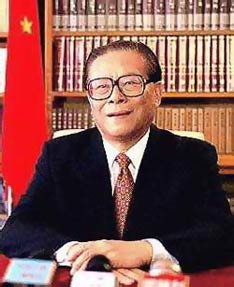 |
Jiang Zemin (江泽民; 江澤民; Jiāng Zémín - born 17 August 1926)
Chinese politician, he was general secretary of the Chinese Communist Party (CCP; 1989–2002) and President of the People's Republic of China from 1993 to 2003. |
In the years after Tiananmen, conservative reformers led by Deng protégé Jiang Zemin (later to become president of China, chairman of both the state Central Military Commission and party Central Military Commission, and general secretary of the CCP) endured and eventually overcame world criticism. When Deng went into retirement, the rising generation of technocrats ruled China and oversaw its modernization. Political progress gradually occurred. Term limits were placed on political and governmental positions at all levels, succession became orderly and contested elections began to take place at the local level. Tens of thousands of Chinese students went overseas to study; many returned to participate in the building of modern China, some to become millionaires in the new “socialist economy with Chinese characteristics.” As a sign of its emerging superpower status, in October 2003 China launched its first “taikonaut” into space on a 22-hour journey. The second space launch, with two taikonauts, took place in October 2005 and involved a 115-hour flight. In the next stage of space exploration, China plans to conduct a space walk in 2007 and a rendezvous docking in orbit between 2009 and 2012. It also plans to launch a moon-orbiting unmanned spacecraft by 2007 and to land an unmanned probe on the moon by 2010.
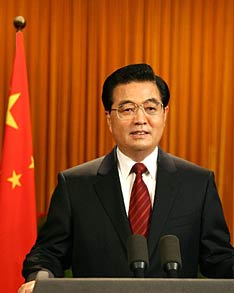 |
Hu Jintao (胡锦涛; 胡錦濤; Hú Jǐntāo - born 21 December 1942)
Chinese paramount leader between 2002 and 2012. He was general secretary of the Chinese Communist Party (CCP) since 2002 and he was the President of PR China from 2003 to 2013. |
As the twenty-first century began, a new generation of leaders emerged and gradually replaced the old. Position by position, Jiang Zemin gradually gave up his leadership role and by 2004 had moved into a position of elder statesman, still with obvious influence exerted through his protégés who were embedded at all levels of the government. The “politics in command” of the Maoist past were subliminally present when technocrat Hu Jintao emerged—by 2004—as the preeminent leader (president of China, chairman of both the state Central Military Commission and party Central Military Commission, and general secretary of the CCP) with grudging acceptance by Jiang and his supporters.
The current President is Xi Jinping, who took office on 14 March 2013.
Main text: Library of Congress
|
 |


